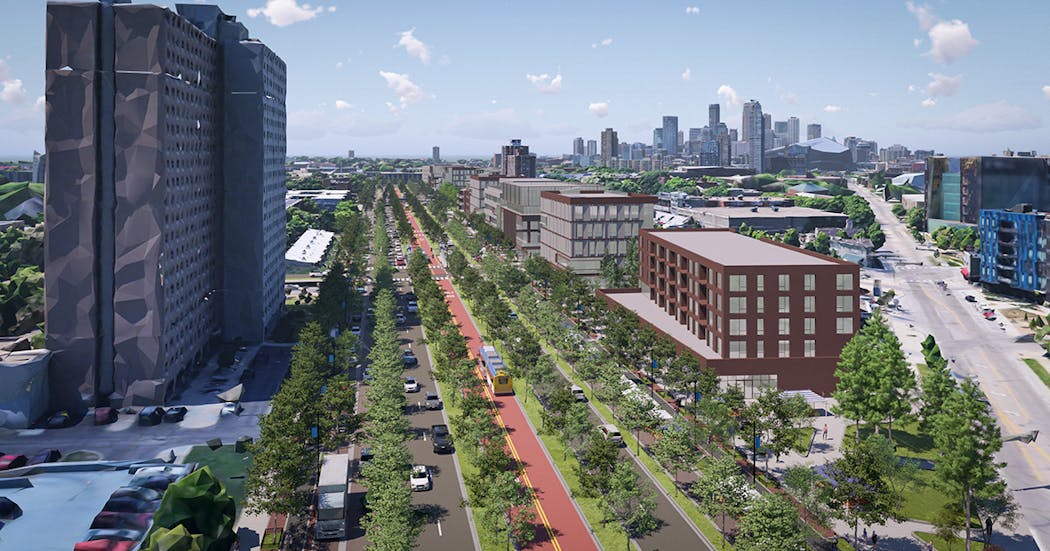As state transportation planners mull the future of Interstate 94 in the Twin Cities, a group that champions transportation not centered on cars wants to convert a 7.5-mile stretch of the freeway between downtown Minneapolis and downtown St. Paul with a street-level thoroughfare.
A recent report by Our Streets Minneapolis said replacing the freeway won't have a negative effect on traffic — as motorists find other routes for what are mostly short trips. But a thoroughfare will be better economically, environmentally and socially for neighborhoods long scarred by the freeway, the report's authors say.
"I think that as we bring more information to the table about the economic benefits of this, and the environmental benefits and just the quality of life and sense of place benefits, more and more people are getting excited," said Alex Burns of Our Streets. "And they are seeing this as an idea that should be legitimately considered."
Our Streets officials hope their report, "Reimagining I-94," will sway planners with the Minnesota Department of Transportation (MnDOT) who are in the midst of their own "Rethinking I-94" project. The state project is evaluating 10 ways of moving forward with an aging and deteriorating stretch of freeway that was built 50-60 years ago and is widely regarded as hurting the inner-city neighborhoods split by the freeway's miles long trench.
Two of the 10 MnDOT alternatives would replace the freeway with a ground level boulevard that includes dedicated bus lanes and bike lanes. Other options being considered range from maintaining the existing stretch of freeway, a combination of a local access roadway with a narrower freeway for motorists passing through and expanding the freeway with additional traffic lanes and lanes for bus rapid transit and carpool lanes.
The Our Streets report, which lists the Toole Design Group, Visible City and Smart Mobility as contributors, comes down clearly on the replace side. Officials said they used MNDOT traffic, speed and congestion data.
The report concluded that highway removal has been a positive step in several other cities, including Rochester, N.Y.; Milwaukee, and Oakland, Calif. Other key findings in the report include:
- Traffic would not be dramatically affected. Most trips on I-94 are short and local, using the freeway only for short distances. The most common average trip duration along this stretch of I-94 is 5 minutes, compared to 15 minutes and 20 minutes for I-494 and I-694 respectively. Most motorists would find other routes through neighborhoods.
- The models the state is using to study alternatives were developed 40 years ago and are not reliable and should not be used to predict congestion and travel times. The Reimaging authors say the state methodology is skewed toward freeways and does not look at the environmental and development benefits of removing the highway.
- Converting to a thoroughfare has enormous potential for transforming hundreds of acres of right-of-way into new space for housing, businesses and parks.
- Less traffic, noise and air pollution will improve the health and well-being of corridor residents.
- Rethinking I-94 is a political decision, not an engineering one. The freeway is not necessary for the Twin Cities to thrive, and if it is rebuilt or expanded, the harms it created will continue.
State and city officials, so far, appear noncommittal.
"We appreciate the deep community interest and involvement as we work to plan the future of this vital corridor," department spokesperson Anne Meyer said in a statement. "MnDOT is considering a wide range of alternatives for the future of this corridor. The alternatives were developed in partnership with federal, state and local governments, as well as countless technical experts and feedback from the community."
Unlike the original creation of I-94 during the 1950s and '60s, she said, officials are "committed to continuing with our community-based approach focused on reconnecting neighborhoods and ensuring community members have a meaningful voice in transportation decisions that affect their lives."
St. Paul City Council Member Anika Bowie, who represents the old Rondo neighborhood where more than 1,000 homes were removed for I-94 construction, said she agrees with Our Streets about the freeway's negative impact. She also supports ReConnect Rondo, a plan to install a 21-acre cap over several blocks of the freeway for housing and commercial development.
"I want to ensure we are going in a positive direction," Bowie said. "I think Our Streets has brought a valuable perspective. Maybe there can be some type of merger of plans. The goal should be to reconnect, rebuild and repair."
Celeste Robinson, a policy aide for Minneapolis City Council Member Robin Wonsley said in an email: "CM Wonsley is still reviewing the report. She is strongly supportive of the boulevard conversion generally but cannot offer comment on the report as of yet."
Brette Hjelle, the interim director of Minneapolis Public Works, said in a statement that public works staff are aware of the Our Streets report and, "We look forward to reviewing and better understanding the contents of that report and the continued dialogue on this important project."
State Rep. Samantha Sencer-Mura, DFL-Minneapolis, said she learned about the idea of converting this section of freeway into a boulevard while campaigning. A member of the House Transportation Committee, she said the the idea is worth considering. "I am generally excited about an at-grade option," she said, adding that a thoroughfare's benefits to air quality and neighborhood livability make it a real alternative. "I'm excited by the possibilities."

Want to share info with the Star Tribune? How to do it securely

'Safe recovery sites' would offer syringes, naloxone and more to people using drugs. The plan could be in peril.
New Minnesota GOP leaders seek peace with party's anti-establishment wing

Who is Republican Lisa Demuth, Minnesota's first House speaker of color?


